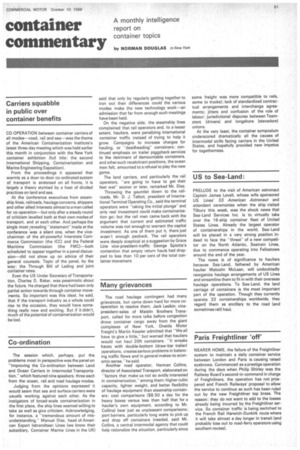Co-ordination
Page 53

If you've noticed an error in this article please click here to report it so we can fix it.
The session which, perhaps, put the problems most in perspective was the panel on "Improving the Co-ordination between Land and Ocean Carriers in Intermodal Transportation," which featured nine speakers, three each from the ocean, rail and road haulage modes.
Judging from the opinions expressed it would seem that sea and surface carriers were usually working against each other. As the instigators of broad-scale containerization in the first place, the ship lines seemed willing to take as well as give criticism. Acknowledging, for instance. a "tremendous amount of misunderstanding," Manuel Diaz, head of American Export Isbrandtsen Lines (we know their subsidiary, Container Marine Lines in the UK) said that only by regularly getting together to iron out their differences could the various modes make the new technology work—an admission that far from enough such meetings have been held.
On the negative side, the steamship lines complained that rail operators and. to a lesser extent. hauliers, were penalizing international container traffic instead of trying to help it grow. Campaigns to increase charges for hauling. or "deadheading" containers: continued emphasis on trailer piggyback services to the detriment of demountable containers, and other such recalcitrant positions, the ocean men felt, amounted to a refusal to play the new game.
The land carriers, and particularly the rail operators. "are going to have to get their feet wet" sooner or later, remarked Mr. Diaz.
Throwing the gauntlet down to the railroads. Mr. D. J. Talbot. president of International Terminal Operating Co., said the terminal operators were "taking the initial plunge" and only real investment could make containerization go; but the rail men came back with the argument that current and estimated traffic volume was not enough to warrant the capital investment. As one of them put it. there just wasn't enough payback. The rail operators were deeply sceptical at a suggestion by Grace Line vice-president-traffic George Spiotta's contention that empty return hauls had dropped to less than 10 per cent of the total container movement.
























































































































